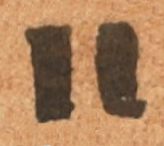hua (Mdz17v)
This element representing the phonetic syllable "hua" has been carved from the compound sign for the place name, Acalhuacan. It consists of two parallel, vertical, black lines. It may come from the verb for making lines (huahuana).
Stephanie Wood
Other possibilities for the "hua" sign shown here do exist. According to Danièle Dehouve, these lines represent rain drops as expressed in face paint (xahualli). Dehouve also points to the possibility of tlaolxahualli, facial paint from rubber, to provide the "hua." See Dehouve, "The Rules of Construction of an Aztec Deity," Ancient Mesoamerica, 31 (2020), 7–28. See, in particular, page 15. She also mentions Lacadena's proposal of the verb huahuana, "to make lines in the earth, make lines on paper."] Presumably, liquid rubber could be painted on the face to create these thick black lines about the width a finger would make.
Alfonso Lacadena has called this "hua" the Tenochtitlan-Tlatelolco "double-stroke sign." See his article, "The wa1 and wa2 Phonetic Signs and the Logogram for WA in Nahuatl Writing," The PARI Journal 8:4 (2008), 38, citing Karttunen 1992. Leonardo Manrique felt the "hua" sign could be translated as "owner, possessor," but as Lacadena points out, it does not work in all cases. Sometimes it is a logogram and sometimes is is a phonogram in a complement role. It is interesting that the double-stroke sign is a reduplication that is both alphabetic and hieroglyphic.
Lacadena also writes about a hua "leaves sign" associated with Tetzcoco that involves two leaves (a phonogram) and a grasping hand (for possessor) hua sign, which he sees as conveying "meaning and sound."
Stephanie Wood
c. 1541, but by 1553 at the latest
double-strike sign, double-stroke sign

huahuana, to make stripes, https://nahuatl.wired-humanities.org/content/huahuana
xahual(li), face paint, https://nahuatl.wired-humanities.org/content/xahualli
tlaolxahual(li) liquid rubber face paint, https://nahuatl.wired-humanities.org/content/tlaolxahualli
-hua-, possessor of, https://nahuatl.wired-humanities.org/content/hua
Codex Mendoza, folio 17 verso, https://digital.bodleian.ox.ac.uk/objects/2fea788e-2aa2-4f08-b6d9-648c00..., image 45 of 188.
The Bodleian Libraries, University of Oxford, hold the original manuscript, the MS. Arch. Selden. A. 1. This image is published here under the UK Creative Commons, “Attribution-NonCommercial-ShareAlike 3.0 License” (CC-BY-NC-SA 3.0).
